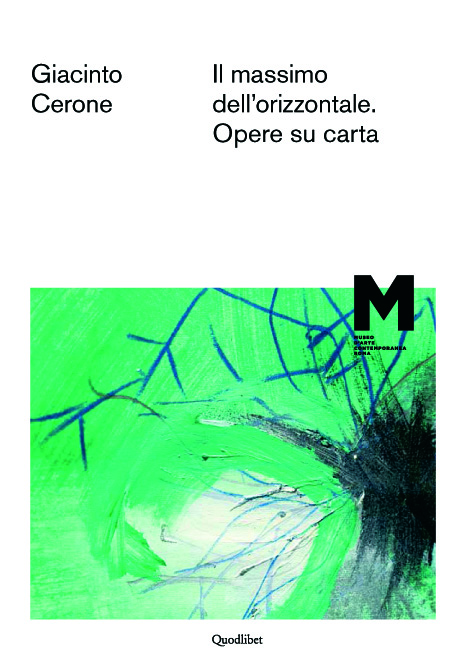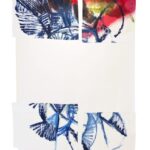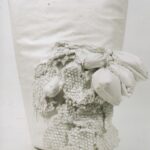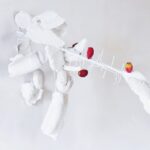Presente imperfetto
Essay in Giacinto Cerone. Il massimo dell’orizzontale, curated by Benedetta Carpi De Resmini, Quodlibet Editions, Rome 2014.

Il massimo dell’orizzontale was the title of an exhibition curated by Benedetta Carpi De Resmini at MACRO in 2014, as a tribute to the sculptor Giacinto Cerone (1957–2004) at the tenth anniversary of his premature death.
Around thirty works on paper were selected, thanks to private and public loans which gave back an almost unknown activity of Cerone.
The catalogue of the exhibition contains texts by Benedetta Carpi De Resmini, Giuseppe Appella, Maria Vittoria Marini Clarelli, Manuela Pacella, Maria Grazia Pontorno and Giosetta Fioroni.
I was asked to study and compare the works of Cerone with the younger generation and I choose Pesce Khete (Rome, 1980) and Luca Trevisani (Verona, 1979).
Present Imperfect
Knowing how to get back up frees us from the inferiority complex that we have in relation to everything and to ourselves… it frees us from our frustrations… from our fragility, from the weakness we have at heart.
Giacinto Cerone, 2001 [1]
I can’t separate my way of conceiving painting practice from the concept of error. The error is proof of an attempt. A failed attempt has in itself a value: the weight of truthfulness.
Pesce Khete, 2014 [2]
There is failure: failure is part of the games; the important thing is to contemplate it.
Luca Trevisani, 2013 [3]
It smacks of hazard to set Giacinto Cerone (Melfi, 1957-Rome 2004) alongside two artists of a completely different generation and training: Pesce Khete (Rome, 1980) and Luca Trevisani (Verona, 1979).
The juxtaposition might border on banality if it was exclusively formal: the drawings of Cerone and the ‘paintings’ on paper of Khete; some plaster works by the older artist and the polyurethane sculptures of Trevisani.
The parallel has, though, such a spontaneous and felicitous origin that it can only hide something much deeper, something that is, de facto, the ribbing of thought that guides the work of the three artists and that turns on the capture of the present.
The three opening quotations refer to the error, the stumble, as a value, and they do it in an interesting progression.
In Cerone there is the capacity of knowing how to get back up – which for him is possessed only by those who are “healthy carriers of disease” – and this ability derives from an interior movement, from a thrust caused by a throb, a natural impulse.
Khete seems almost to look for the error as a revelatory source, since it takes him towards other roads that, though less certain, possess the weight of having been discovered to be truthful.
Trevisani not only admits the failure which is proper to man, but contemplates it.
A freefalling nosedive, a revelation of truth and an ensuing contemplation. It seems almost like observing three human positions photographed in paratactic progression à la Muybridge, arriving, with Trevisani, to a meditative act. It’s not at all a coincidence that of the three it is Trevisani who often has the flavour of the cryptic, but we’ll come to this later on.
Giacinto Cerone and Pesce Khete have a characteristic that unites them and that takes its starting point, here too, from an error. In this case, though, it is a false judgment, deriving from a by-now superficial habit of wanting to label at all costs. Observing their works, what pushes immediately to a definition, without any ill-concealed criticism, is the impetuousness of the gesture that makes the consequence of that action expressive. But here, we remain in the territory of the superficial. That expressiveness is without doubt there, as, obviously, the gesture that has created it was there, but this doesn’t derive from an irrational uncontrollable impulse.
In the case of Cerone, Raffaele Gavarro explains this well. It is a question of a “language that is able to correspond to the conditions of the present not through the outcomes of a strongly expressive gestural art, but instead by finding the modality to give an account of an out-and-out identification with the very idea of the present and with the conditions that it imprints on the world. (…) The idea of the instant that contains all imaginable time is the result of a perception through intuition.”[4]
Cerone imprints that present on material, especially malleable material like plaster and terracotta. Many of his sculptures seem to be three-dimensional photographs where other material robbed from time, like lace and packaging-like plastics, leave the trace of that instant and where the natural element, like an artichoke or roses, becomes the atemporal icon that substitutes the human one.
Cerone didn’t at all shun figurative work, though often the viewer has to look for it within a visual path of ascents and entwinings, in a material scoured powerfully by that frenzy of the present. The same thing goes for his graphic work, which goes hand in hand with his sculpting. For Cerone drawing was like telephoning: “They’re very similar practices. For me they’re both activities of projection.”[5]
He drew on the floor, often with both hands because as a child his left-handedness was contested. As an adult, then, he was able to take advantage of a constriction he’d been subjected to in childhood. Cerone immersed himself in the world of drawing and painting as in that of terracotta work. This immersion followed his thought.
You can’t fail to notice how most works on paper by Cerone are vertical, some markedly so. Drawing, prevalently on the floor, on a very long sheet, in itself means a total involvement in the symbolic meaning of these two opposites. It isn’t by chance that Benedetta Carpi De Resmini entitled the exhibition that this piece has been written for Il massimo dell’orizzontale [The Maximum of the Horizontal]. Visiting it, we are struck by precisely the opposite. The title is a direct quote from Cerone taken from a piece by Domenico Brancale written in 2006 on the occasion of an exhibition of drawings and sculptures at the Gasparelli Gallery in Fano.[6]
The symbolism of vertical and horizontal is so simple as to prove embarrassing to talk about. It suffices to say that among the longest drawings on display there is the series made on the occasion of the exhibition Ofelia in traum. Ophelia was a figure dear to Cerone, represented also in sculpture, laid on the ground with an evident sepuchral reference. Drawing on the ground, horizontally, on vertical sheets of paper, is a struggle between life and death – a being in equilibrium.
Pesce Khete is another trapeze artist, one who finds a certain formal correspondence with the Cerone’s sheets of paper cited above. There is also an evident synergy with that sort of blue and red tree, made around 2000 and part of the exhibition, whose semantic unity was found by Cerone in putting together several sheets of paper. This procedure is the heart of Khete’s practice. The young Roman artist doesn’t, however, assemble the different sheets to construct an organic composite; paper, for Khete, is time’s paintbrush. Observing his work over the years, there are some constants: the support, that paper; the unification of various cuttings with adhesive tape (also of paper); the use of oil sticks. We note, though, a slow, progressive abandonment of figurative representation (which is absent in Cerone). In Khete this happens precisely through that margin of error that the artist finds true; through that chance to add, to correct, again with paper. Khete works on a small scale, with in front of him only a portion of white – a fraction of time, then, that which he is experiencing. He goes forward gradually, perhaps in a trance, because he has in mind, unconsciously, all the rest of the time that surrounds him. The past re-emerges from old works left unfinished, from which he extracts parts that enter into perfect dialogue with the work being carrying out. Later, instead, he adds, and this addition is experienced as a future possibility of equilibrium. It’s a matter of giving the present some space, some air, some light.
We glimpse pieces of reality in Khete, like the sphere that he doesn’t quite manage to abandon, so similar to some present in Cerone’s sheets. But he finds harmony then thanks to another medium, analog photography, the photographs enlarged by the artist, however, sometimes desaturated, and positioned so as to balance the colour and marks present in the paper. This happens at every single exhibition, where the (very often vertical) series of sheets is balanced by or coupled with an enlarged photograph. It almost seems that Khete wants to continually remind himself and others of the great gift of photography, that of releasing painting forever from the obligation of figurative depiction.
continue after images…
Cerone, as many recall, had an obsession with time. In a dialogue with Gian Ruggero Manzoni in 2001 he spoke at length of the fear he had in relation to a new material that the gallerist Mazzoli had offered to him to work with, marble. Scanning the artist’s words, a smile comes at the thought of the marble sculptures he was shortly to make. What he was most afraid of was confronting immortality, the power that marble is capable of giving, and the professional success that might come of this collaboration.[7]
Here is the real generational divergence between Cerone and Khete and Trevisani’s generation. Perhaps it isn’t an out-and-out divergence so much as an intuition that, in Cerone’s time, was hovering in the air, and that then became simply natural.
There’s a piece Luca Cerizza has written on Trevisani that is really illuminating about his work. Citing Zygmunt Bauman with regard to the second, “liquid” modernity, Cerizza speaks of success as “tied to the components of lightness, transferability, speed and reduction.” And later: “Our condition as inhabitants of modernity, our very identity, will be more and more subject to nomadism, unpredictability and flexibility. The borders will be more porous and indistinct (…) After all in liquid modernity there isn’t room for the very idea of totality, for the possibility of an original unity from which there derive the forms and appearances of the world.”[8]
Trevisani defines himself as a chemist or cook because the experience he has – and that the viewer has – is not mental but more physical (how not to think of Cerone), or at least this must have precedence. Differently from Cerone, in Trevisani often the fruit is real and so is affected by time. Trevisani vies with time in such a human manner that his work becomes charged with attractive power for a wholly natural quality – its fragility and evanescence. In its being so “liquid”, on the other hand his work leaves mnemonic traces of a narrative path that characterizes every experience. He himself defined this elusiveness during a lecture given at the MACRO in Rome in 2013. Trevisani spoke of the monument as the custodian of values but as preserving them not through their dissimulation in treasure chests or pompous sculptures set in the middle of roundabouts; by such commemorations, the opposite result is obtained – forgetfulness.
“I always thought it was important to make fragile things, or things that can go away, that need our attention because it’s the only way to establish a dialogue, even if they’ll no longer be there. The mnemonic element, like in a dream, will be the most important thing, and in this sense the sculpture becomes truly powerful because it remains infused in this rapport we’ve had with a memory; like the power of dreams, which every now and then re-emerge and construct our present as well.”[9]
Some installations by Trevisani are like passages through narrations made by relationships that are created among the individual works and between these and the viewer. Some works, particularly the sculptures, proudly display a fragility masked by a solid body (as in the series Marmomarmalade [Jammarble] of 2013). The videos and photographs, instead, live the same life as an event.
Some polyurethane sculptures by Trevisani closely resemble the plaster works of Cerone. As touched on above, there is an exquisitely formal kinship that in reality conceals a methodology of opposite workmanships: Cerone prints the present; Trevisani creates it.
Instead, it is in the photographs on aluminium that we glimpse a very strong empathy of approach to reality. Like with Khete, it seems that photography is the handmaiden that resolves some problems. What Trevisani’s photographs reveal is an event, an occurrence created by him that occurred before the very slow light of a scanner. Like last-generation cinema frames they animate a two-dimensional surface with an event that truly happened, with an energy developed in front of a slow lens that X-rayed it.
In Cerone’s sculptures, the senses perceived the events and imprinted them, printed them, on the material.
In effect the thousand doubts that Cerone had earlier with regard to confronting marble are absolutely understandable in light of the analyses just made.
The healthy carrier of disease felt hunted when faced with marble.
Death and sickness, the obsessions of Cerone.
He spoke of them often, in several recordings. In this regard Manzoni has written: “In the contemporary world Giancinto’s art becomes, then, one of rift, of reflective but pugnacious verification, of lacerating split in relation to the canon, reaffirming that the only ‘avant-garde’ today practicable is in tradition, in this referring to it, this making future out of memory, this saying of the past as a possibility for tomorrow. Cerone knew that, in the contemporary world, the absence of shared and stratified codes of behaviour (the lack of values) is underpinned by a Western social fabric by now compacted and homogeneous to such a point (in its consumerist absurdity) as to resemble the mathematical continuum that constitutes the framework of a closed architecture: so close a weave as to not allow gaps or rifts (… that is, possible divergences from a state of anaesthetized indifference). Those gaps and rifts that pain and death cause. In fact, the discontinuities in the ‘abounding fake vitalism’ (so in fashion) that sickness and death cause are mostly scandalous because they highlight the emptiness of an existence from which every kind of emotion must be eradicated with appropriate means. For this reason there is a full, total coherence between a strongly ‘compressed-homologated’ (alienated) model of society and the gradual extinction of human passions perpetrated through the systematic removal of the symbolic forms that incarnate the most elementary and basic stages of existence.”[10]
Trevisani too speaks of illness, making reference to it in relation to the Flogisto [Phlogiston] (that is, the concept that underpins all works that originate in front of the scanner’s light); an invitation to think of “illness as a metaphor”,[11] as a privileged entry to observe a still life – natura morta in Italian – as it dies.
Khete no, he doesn’t speak of it and it isn’t necessary that he should.
Here I want only to highlight the way that Cerone involuntarily created a vital generational line that believes in human error, that doesn’t pull back when verticality collapses and that has the courage not to flee the present, because the present is the mirror of all that has been and will be, the reflection of incessant passing. The ambition to stop it is the aspiration to immortality. Not to sculpt marble but to use the fragments of reality that will soon transform into memories. The memory is like the dream. From the past and from the dream world images arrive continually that help to construct the present. It isn’t necessary to chase after the ineffable; there’s no need to stop the breath when faced with something that smacks of abandonment – this will come back thanks to the power that man has to let ghosts re-emerge, to look at them again, taste them and let them again go away, in a continuous construction of a present that must necessarily remain imperfect.
Manuela Pacella
[1] Quoted in Alessia Olivieri, Giacinto Cerone – Gian Ruggero Manzoni. Il Giardino dei Giusti, Edizioni Essegi, Villanova di Ravenna 2001, p. 20.
[2] Quote taken from a written statement by Pesce Khete, June 2014.
[3] Quote taken from the video made on the occasion of Luca Trevisani’s residency at the MACRO, Rome (14 January – 14 May 2014).
[4] Raffaele Gavarro, Il tempo e lo spazio nel cuore profondo della materia in Angelandreina Rorro, Giacinto Cerone. 1957-2004, Electa, Milano 2011, pp. 41, 42.[5] Alessia Olivieri, Giacinto Cerone – Gian Ruggero Manzoni. Il Giardino dei Giusti, op. cit., p. 99.
[6] Domenico Brancale, La crisalide di pietra in Giacinto Cerone. Sui Sentieri di Ho Chi Minh, Gasparelli Arte Contemporanea, Fano 2006, n.p.
[7] Alessia Olivieri, Giacinto Cerone – Gian Ruggero Manzoni. Il Giardino dei Giusti, op. cit., circa pp. 61-72.
[8] Luca Cerizza, Ipotesi verosimile sulla scomparsa dell’angolo retto in Luca Trevisani. The effort took its tools, Argobooks, Berlin 2008, n.p.
[9] Quote taken from the lecture given on the 17th April 2013, MACRO, Rome.
[10] Gian Ruggero Manzoni, Sui Sentieri di Ho Chi Minh, in Giacinto Cerone. Sui Sentieri di Ho Chi Minh, op. cit.
[11] Direct quotation from Illness as Metaphor written by Susan Sontag in 1978.


